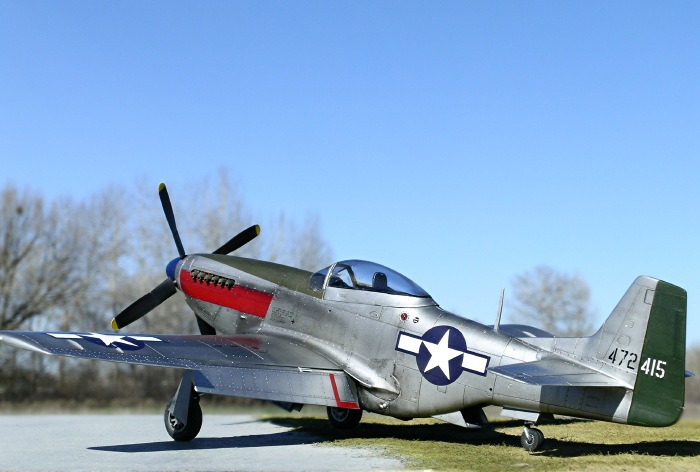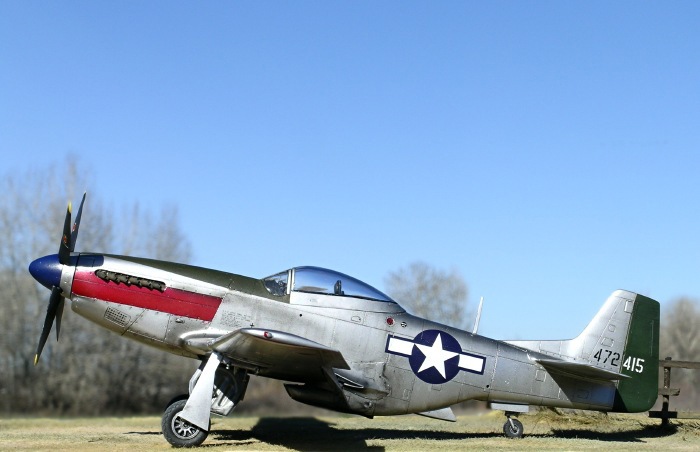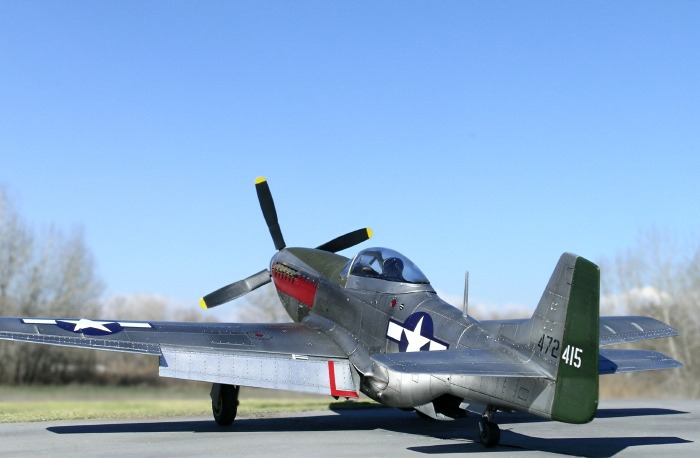|
1/48 scale photo recon
escort
P-51D Mustang
by
Ian Robertson
|
 |
|
P-51D Mustang |

Tamiya's 1/48 scale P-51D Mustang is available online from Squadron.com
Decal manufacturers have had a field day producing
striking and elaborate nose art for P-51 Mustangs. One need only survey
the extensive galleries on Hyperscale to get a taste for the diversity
of attractive markings available. However, these examples may lead one
to conclude that all mustangs were adorned with elaborate artwork. In
fact, many were rather plain. Here I present a P-51D with a simple
scheme that caught my eye. I found it in a color profile in Roger
Freeman’s “American Eagles: P-51 Units of the Eighth Air Force”.

The aircraft I chose to model belonged to the 7th Photographic
Reconnaissance Group stationed in Chalgrove, spring 1945. This aircraft,
along with a handful of others, was assigned as fighter escort for the
group’s unarmed, camera-equipped F-5 Lightnings. Other than the serial
numbers on its tail, no identification markings were carried. Aircraft
in the group had a red panel under each exhaust, a dark blue spinner,
and a dark green rudder. In other reconnaissance groups the color on the
rudder was different.
Tamiya’s P-51D Mustang is arguably the best
bubbletop Mustang available in 1/48 scale, although Hasegawa produces a
very nice product as well.
One advantage of the Tamiya kit over the Hasegawa
offering is the option for dropped flaps. Surface detail on the kit is
excellent, and the cockpit is adequately detailed, although replacement
resin cockpits are available for those inclined.
A weakness/annoyance of the Tamiya kit, for me at least, is that the
lower canopy frame is not molded as part of the bubble canopy as it is
in the Hasegawa kit. As a result, the modeler is forced to make a long
and awkward join between the two parts, usually with a less than perfect
result. Moreover, the attachment of the clear parts to the sprue tend to
leave scars on the canopy that are problematic to clean up. Vacuform
canopy replacements are available, but they too can be difficult to work
with. I opted to make do with the kit’s canopy, although I spent
considerable time cleaning it up.

I added resin exhausts and propeller blades from Ultracast, and etched
metal seatbelts from Eduard. I scavenged the white and black serial
numbers from an Aeromaster P-51 decal sheet. The remainder of the decals
used were from the kit.
Rivet detailing was added to the fuselage but not to the wings since the
rivets on the wings would have been filled and primed on the real
aircraft. I used “Rosie the Riveter”, a rivet making tool marketed by
Petr Dousek in the Czech Republic. A review of Petr’s line of pounce
wheels can be found at
http://www.largescaleplanes.com in the reviews section. The
particular tool I used had 0.7 mm spacing between the teeth.
The cockpit was painted interior green with a
woodgrain decal for the floor panel. The radio equipment behind the
pilot’s seat was painted flat black as per the instructions.
Shifting to the exterior, the model was sprayed with Mr. Surfacer 1000
as a primer for the Alclad II metalizer, and then buffed lightly with
micromesh sanding cloths. It is essential to have a smooth primer coat
for metalizers since they show off any scratches or imperfections on the
surface. Various shades of Alclad II were used for the natural metal
finish, including duraluminum, aluminum, semi-matte aluminum, dark
aluminum, and polished aluminum. Once the Alclad finish was complete, I
masked and sprayed Tamiya red (X-7) on the cowl side panels, Tamiya
olive drab (XF-62) for the anti-glare panel, and Tamiya olive green
(XF-58) with a touch of black on the rudder. The spinner was painted
with Tamiya Royal Blue (X-3).

To tone down the shiny natural metal finish to a more realistic wartime
appearance, I applied several washes of Tamiya black acrylic,
particularly on the lower nose and around the wing roots. These washes
dulled the metal finish and darkened the panel lines to match my
reference photos. On the underside I sprayed a much heavier application
of the black wash in the direction of airflow, particularly behind the
radiator.
As a final step, the non-control surfaces of the wings were sprayed with
a clear dull coat. The wings of mustangs were primed and painted silver,
and thus were not as reflective as the natural metal on the fuselage.
The wheel wells were painted aluminum with the rear spar painted yellow
chromate.
The P-51D Mustang is a fine looking aircraft no
matter how it’s dressed up.
Photographs
Images were taken outdoors with a Nikon Coolpix
5400 digital camera. The “unsharp mask” tool of Adobe Photoshop was used
to restore some of the clarity and crispness lost during image
compression, and a blur tool was used to diffuse the rear edge of the
base with the background.
Click on the thumbnails
below to view larger images:
P-51 Mustang
From the RAF to the Mighty Eighth
Special Editions (Aviation) 1 |
|
|
|
|
Author: Michael O'Leary
US Price: $10.95
UK Price: £6.99
Publisher:
Osprey Publishing
Publish Date:
September 15, 1997
Details: 128 pages; ISBN: 1855327147 |
|
|
Model, Images and Text Copyright ©
2005 by Ian Robertson
Page Created 20 April, 2005
Last Updated 20 April, 2005
Back to HyperScale
Main Page
|
Home
| What's New |
Features |
Gallery |
Reviews |
Reference |
Forum |
Search